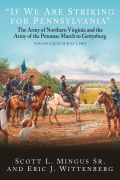site search
online catalog
“IF WE ARE STRIKING FOR PENNSYLVANIA”: THE ARMY OF NORTHERN VIRGINIA AND THE ARMY OF THE POTOMAC MARCH TO GETTYSBURG – VOLUME 2: JUNE 23 – 30, 1863

$34.95
Quantity Available: 1
Item Code: ST501217
Shipping: Determined by Method & Location of buyer
To Order:
Call 717-334-0347,
Fax 717-334-5016, or E-mail
Mingus, Sr., Scott L. and Eric J. Wittenberg. Savas Beatie, May 2023. Hardcover w/dustjacket; 24 maps, 75 images, 432 pp.
Award-winning authors Scott L. Mingus Sr. and Eric J. Wittenberg are back with the second and final installment of “If We Are Striking for Pennsylvania”: The Army of Northern Virginia’s and Army of the Potomac’s March to Gettysburg. This compelling and bestselling study is the first to fully integrate the military, political, social, economic, and civilian perspectives with rank-and-file accounts from the soldiers of both armies during the inexorably march north toward their mutual destinies at Gettysburg.
Gen. Robert E. Lee’s bold movement north, which began on June 3, shifted the war out of the central counties of the Old Dominion into the Shenandoah Valley, across the Potomac, and beyond. The first installment (June 3-22, 1863) carried the armies through the defining mounted clash at Battle of Brandy Station, after which Lee pushed his corps into the Shenandoah Valley and achieved the magnificent victory at Second Winchester on his way to the Potomac. Caught flat-footed, Maj. Gen. Joseph Hooker used his cavalry to probe the mountain gaps, triggering a series of consequential mounted actions.
The current volume (June 23-30) completes the march to Gettysburg and details the actions and whereabout of each component of the armies up to the eve of the fighting. The large-scale maneuvering in late June prompted General Hooker to move his Army of the Potomac north after his opponent and eventually above the Potomac, where he loses his command to the surprised Maj. Gen. George G. Meade. Jeb Stuart begins his controversial and consequential ride that strips away the eyes and ears of the Virginia army. Throughout northern Virginia, central Maryland, and south-central Pennsylvania, civilians and soldiers alike struggle with the reality of a mobile campaign and the massive logistical needs of the armies.
Untold numbers of reports, editorials, news articles, letters, and diaries describe the passage of the long martial columns, the thunderous galloping of hooves, and the looting, fighting, suffering, and dying. Mingus and Wittenberg mined hundreds of primary accounts, newspapers, and other sources to produce this powerful and gripping saga. As careful readers will quickly discern, other studies of the runup to Gettysburg gloss over most of this material. It is simply impossible to fully grasp and understand the campaign without a firm appreciation of what the armies and the civilians did during the days leading up to the fateful meeting at the small crossroads town in Adams County, Pennsylvania. [ld] [ph:L]
~~~~~~~~~~~~~~~~~~~~~~~~~~~~~~~~~~~
THIS ITEM, AS WITH ALL OTHER ITEMS AVAILABLE ON OUR WEB SITE,
MAY BE PURCHASED THROUGH OUR LAYAWAY PROGRAM.
CLICK HERE FOR OUR POLICIES AND TERMS.
THANK YOU!
Inquire About “IF WE ARE STRIKING FOR PENNSYLVANIA”: THE ARMY OF NORTHERN VIRGINIA AND THE ARMY OF THE POTOMAC MARCH TO GETTYSBURG – VOLUME 2: JUNE 23 – 30, 1863
For inquiries, please email us at [email protected]
Most Popular
Historical Firearms Stolen From The National Civil War Museum In Harrisburg, Pa »
Theft From Gravesite Of Gen. John Reynolds »
Selection Of Unframed Prints By Don Troiani »
Fine Condition Brass Infantry Bugle Insignia »
British Imported, Confederate Used Bayonet »
Scarce New Model 1865 Sharps Still In Percussion Near Factory New »
featured item
CONFEDERATE OFFICER’S BELT WITH TWO-PIECE VIRGINIA PLATE AND DRAGOON REVOLVER HOLSTER
The belt plate is a Viriginia two-piece interlocking plate of very good quality. Belt loops for tongue and wreath are plain, slightly beveled. The wreath is a laurel wreath with berries, secured with crossed ribbons at top and bottom. The leaves,… (1283-03). Learn More »
site search
Upcoming Events
May 16 - 18: N-SSA Spring Nationals, Fort Shenandoah, Winchester, VA Learn More »



